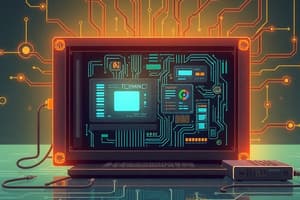Podcast
Questions and Answers
What are the critical parts of an information system?
What are the critical parts of an information system?
- People, procedures, software, hardware, data, and the Internet (correct)
- Software, data, and hardware only
- Users, operating systems, and network hardware
- Data, applications, and cloud storage
How do efficiency and effectiveness relate to technology use?
How do efficiency and effectiveness relate to technology use?
- They help to maximize the use of technology
- They are determined solely by the software used (correct)
- They only focus on hardware improvements
- They emphasize user satisfaction over technology
What is a characteristic of system software?
What is a characteristic of system software?
- It operates independently of hardware
- It includes programs for specific tasks
- It only manages hardware components (correct)
- It is designed to interface directly with users
Which categories do application software fall into?
Which categories do application software fall into?
What does integrating technology with people entail?
What does integrating technology with people entail?
Flashcards are hidden until you start studying
Study Notes
Information Technology, the Internet, and You
- The course aims to make students effective computer users.
- An information system is made up of interconnected parts: People, Procedures, Software, Hardware, Data, and Internet.
- People are vital in an information system and interact with computers both directly (e.g., word processing) and indirectly (e.g., computers in healthcare).
- Procedures are documented rules for using the information system, usually found in manuals.
- Software refers to programs that give instructions to computers.
- There are two types of software - system software and application software.
- System software acts as a "background" program, managing computer resources and enabling interaction with hardware.
- System Software is comprised of an operating system (e.g., Windows, Mac OS) and utilities (e.g., antivirus programs).
- Application software is "end-user" software designed for specific tasks.
- Application software can be categorized as general-purpose (e.g., browsers, word processors), specialized (e.g., graphic design software), or mobile apps.
- Hardware refers to the physical computer equipment, including smartphones, tablets, keyboards, mice, displays, system units, and other devices.
- Hardware is controlled by software.
- There are four types of computers: supercomputers, mainframe computers, midrange computers, and personal computers.
- Personal computers include desktops, laptops, tablets, smartphones, and wearables.
- A personal computer's hardware consists of the system unit, input/output devices, secondary storage, and communications.
- The system unit houses the core components, including the microprocessor for data processing and memory (RAM) for temporary storage.
- Input devices translate data and programs into a computer-readable format, such as keyboards and mice, while output devices translate processed information back to humans, such as the display (monitor).
- Secondary storage devices store data and programs even when the computer is off, including hard disks, solid-state storage, and optical discs (CDs, DVDs, Blu-ray).
- Communications devices like modems allow computers to connect and share information with other systems.
- Data is raw, unprocessed facts including text, numbers, images, and sounds.
- Processed data becomes information.
- Digital data is stored electronically in files, including document files (word processor), worksheet files (spreadsheet), database files (structured data), and presentation files (presentation graphics).
- Almost all information systems provide connectivity to other people and computers using the Internet.
- Connectivity is the ability to share information between systems using a network, the largest of which is the internet.
- The World Wide Web provides a multimedia interface to resources on the Internet.
- Key drivers of the impact of technology include cloud computing, wireless communication, and the Internet of Things (IoT).
- Cloud computing uses the internet to move computer activities from individual computers to the internet.
- The wireless revolution allows for communication without physical cables, and the IoT connects everyday objects with electronic devices to share data over the internet.
Studying That Suits You
Use AI to generate personalized quizzes and flashcards to suit your learning preferences.




